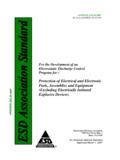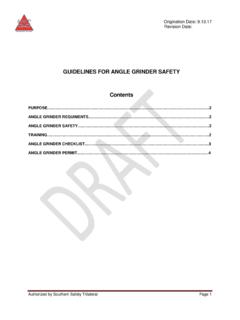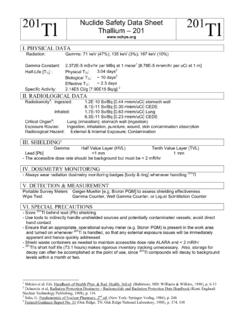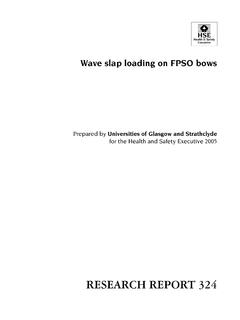Transcription of for the Protection of Electrostatic Discharge …
1 ANSI/ESD S541-2003 for the Protection of Electrostatic Discharge susceptible Items Packaging Materials for ESD Sensitive Items Electrostatic Discharge Association 7900 Turin Road, Bldg. 3 Rome, NY 13440 An American National Standard Approved 3/25/2003 ANSI/ESD S541-2003 ESD Association Standard for the Protection of Electrostatic Discharge susceptible items Packaging Materials for ESD Sensitive Items Approved February 9, 2003 ESD Association i ESD Association standards and publications are designed to serve the public interest by eliminating misunderstandings between manufacturers and purchasers.
2 Facilitating the interchangeability and improvement of products and assisting the purchaser in selecting and obtaining the proper product for his particular needs. The existence of such standards and publications shall not in any respect preclude any member or non-member of the Association from manufacturing or selling products not conforming to such standards and publications. Nor shall the fact that a standard or publication is published by the Association preclude its voluntary use by non-members of the Association whether the document is to be used either domestically or internationally.
3 Recommended standards and publications are adopted by the ESD Association in accordance with the ANSI Patent policy. Interpretation of ESD Association Standards: The interpretation of standards in-so-far as it may relate to a specific product or manufacturer is a proper matter for the individual company concerned and cannot be undertaken by any person acting for the ESD Association. The ESD Association Standards Chairman may make comments limited to an explanation or clarification of the technical language or provisions in a standard, but not related to its application to specific products and manufacturers.
4 No other person is authorized to comment on behalf of the ESD Association on any ESD Association Standard. Published by: Electrostatic Discharge Association 7900 Turin Road, Bldg. 3 Rome, NY 13440 Copyright 2003 by ESD Association All rights reserved No part of this publication may be reproduced in any form, in an electronic retrieval system or otherwise, without the prior written permission of the publisher. Printed in the United States of America ISBN: 1-58537-050-9 Caution Notice ii(This foreword is not part of ESD Association Standard ANSI/ESD S541-2003) FOREWORD Packaging is necessary to protect electronic items from physical and environmental damage during manufacture, transportation, and storage.
5 While most types of packaging (not for static sensitive items) provide physical and environmental Protection , it also may harm static sensitive electronic items by allowing the accumulation or the Discharge of static electricity. (See appendix B for device damage information.) Packaging for ESD sensitive items is commonly derived by modifying existing packaging to prevent the packaging itself from causing static damage. The packaging generally retains its physical and environmental protective qualities. ESD protective packaging has been modified further to prevent other sources of static electricity from damaging a packaged item.
6 This can be illustrated by considering bags. Polyethylene bags are useful packages for containing items and providing Protection from physical and environmental damage. However, polyethylene bags accumulate potentially damaging amounts of static electricity. Chemicals (antistats) are added to the polyethylene bag to render it low charging. The result is a low charging (antistatic) polyethylene bag that is less likely to damage static sensitive items. By adding a conductive layer to the low charging polyethylene bag, an ESD shielding bag is created. This shielding bag is low charging, and shields packaged items from ESD and the electric field generated by other items.
7 Other standard packaging including paper corrugate and plastic boxes, trays, and clamshells have, or are presently, following similar paths. A complete ESD Control Program, as defined by ANSI/ESD , requires the use of ESD protective packaging to properly manufacture, transport, and store ESD sensitive devices. This Standard provides requirements for ESD protective packaging that must be included inside and outside an Electrostatic Protected Area (EPA). Because most physical and environmental considerations can be left to traditional packaging design and testing methodologies, only the material properties that provide reduction or prevention of damage from static electricity need be addressed.
8 This standard describes the packaging material properties needed to protect Electrostatic Discharge (ESD) sensitive electronic items, and references the testing methods for evaluating packaging and packaging materials for those properties. Where possible, performance limits are provided. Guidance for selecting the types of packaging with protective properties appropriate for specific applications is provided. Other considerations for protective packaging are also provided. This document is a substantial refinement of Electronic Industries Association Standard EIA-541-1988. Updates include the adoption of surface resistance (Ohms) in place of surface resistivity (Ohms/square), volume resistance (Ohms) in place of volume resistivity (Ohm-cm), a shielding test that allows penetrating energy (nanoJoules) to be calculated in place of a voltage measurement (volts), and limits the use of static decay testing.
9 While new to 541, these methods have been in use for five years. Resistance is no longer the only property that is used to classify ESD packaging. Low Charging, Electric Field Shielding and Direct Discharge Shielding have been added. iii COMMENTS Beneficial comments (recommendations, additions, deletions) and pertinent data, which may be of use in improving future versions of this document, should be addressed to: ESD Association Chair, Packaging Standards Workgroup 7900 Turin Road, Bldg. 3 Rome, NY 13440 COMMITTEE MEMBERS Brent A. Beamer, Chairman Static Control Components, Inc Joe Blanchard Bradford Company Walt Gately Gately & Associates, Inc.
10 Kyung J. Kim BF Goodrich SCP Rick Knight Ranger Plastic Extrusions, Inc. Stephen Koehn 3M William Metz Hewlett Packard Carl Newberg River's Edge Technical Service / Microstat Dale Parkin IBM Charles Perry Monroe Electronics Bob Vermillion RMV Technology Group, LLC Stan Weitz Electro Tech Systems The following individuals made significant contributions to this document: Ryne Allen Ben Baumgartner ESD West Steve Fowler Fowler Associates Larry Fromm Finisar Steve Gerken US Air Force Ron Gibson Celestica David E. Swenson Affinity Static Control Consulting iv Table of Contents PURPOSE 1 SCOPE 1 REFERENCED PUBLICATIONS 1 DEFINITIONS 1 PERSONNEL SAFETY 1 PACKAGING APPLICATION REQUIREMENTS 2 Inside an EPA 2 Outside an EPA 2 Tailoring 3 CLASSIFICATION OF ESD PACKAGING MATERIAL PROPERTIES 2 LOW CHARGING (ANTISTATIC)






